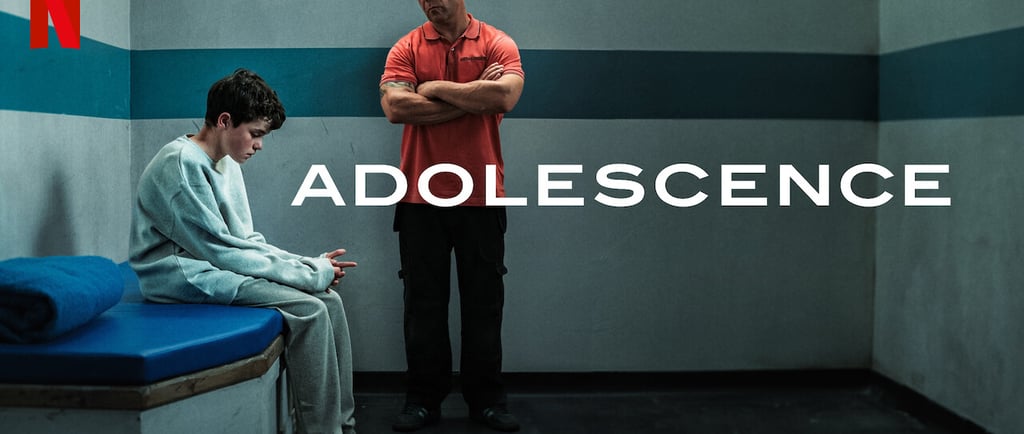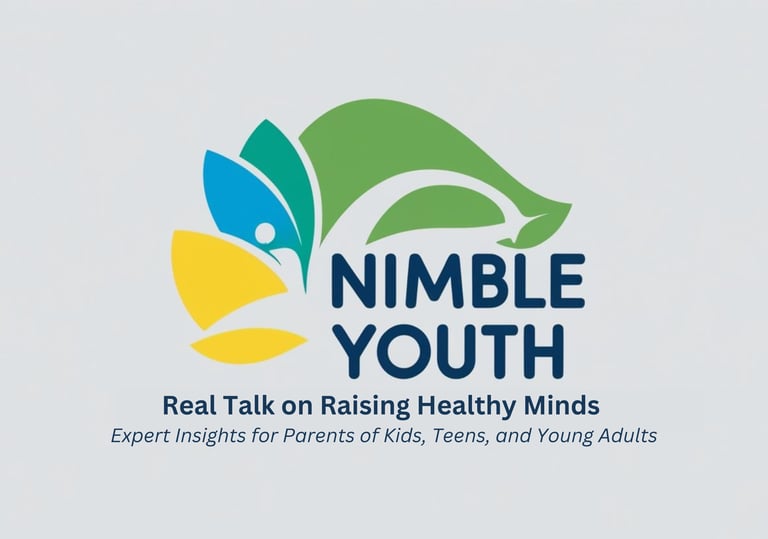Episode 27: “Adolescence”: Why a British Crime Drama About a 13-Year-Old Boy Is Resonating Worldwide
In Episode 27, Matt and Dr. Gretchen Hoyle dive into the British Netflix sensation Adolescence, a four-episode psychological crime drama that has captured global attention and sparked urgent conversations about boys, mental health, peer dynamics, and the pressures of early adolescence.
M. Butterman
11/23/20253 min read


Episode 27 - “Adolescence”: Why a British Crime Drama About a 13-Year-Old Boy Is Resonating Worldwide
Host: Matt Butterman
Guest: Dr. Gretchen Hoyle, MD — Pediatrician with 25 years of clinical practice
Series: Nimble Youth: Conversations in Pediatric Mental Health
📺 Episode Overview
In Episode 27, Matt and Dr. Gretchen Hoyle dive into the British Netflix sensation Adolescence, a four-episode psychological crime drama that has captured global attention and sparked urgent conversations about boys, mental health, peer dynamics, and the pressures of early adolescence.
Premiering on March 13, 2025, Adolescence quickly became a phenomenon:
66 million views in its first two weeks
141 million+ views by month three
Metacritic score: 91/100
Called by critics “as close to TV perfection as the medium gets”
The series tells the story of Jamie Miller, a 13-year-old boy arrested for murdering a classmate. Told in single-take, real-time episodes, the show captures the intensity of early adolescent psychology—bullying, online shame, emerging masculinity, family strain, and the vulnerability of identity at age 13.
Matt and Dr. Hoyle discuss why the show has resonated so profoundly, what it reveals about youth culture today, and how clinicians, educators, parents, and advocates can use it as a tool for conversation and prevention.
🎞️ What Makes Adolescence So Impactful?
Dr. Hoyle unpacks the factors driving its global reach:
Authenticity of teen experience:
Not glamorized. Not sanitized. Honest about pain, invisibility, and peer cruelty.
Single-take cinematography:
Long, uninterrupted scenes heighten tension and mirror the relentless emotional world of adolescents.
🧠 Five Key Themes the Show Gets (Uncomfortably) Right
1. Peer Culture & Social Media Pressure
Jamie’s journey is fueled by:
Viral humiliation
Digital micro-bullying
Online shame loops
Constant comparison
Pressure to perform socially 24/7
Clinically: Ages 11–15 are where Matt and Dr. Hoyle see the highest sensitivity to peer feedback and online ecosystems.
2. Masculinity, Entitlement & Manosphere Influences
The show portrays how boys can be pulled toward:
Misogynistic online communities
“Incel” identity narratives
Resentment-based belonging
Anger as a coping mechanism
Referenced thinkers:
Jonathan Haidt – The Anxious Generation
Richard Reeves – Of Boys and Men
Scott Galloway on boys’ struggle for identity and meaning
3. Family System Strain & Parenting Fatigue
Jamie’s parents are overwhelmed—working, caregiving, juggling screens, and blindsided by their son’s online world.
Clinically:
This mirrors what pediatricians see every day — exhausted families, fragmented attention, and hidden digital lives.
4. Early Adolescent Identity (Ages 13–15)
Dr. Hoyle emphasizes:
Puberty + cognitive shift
Peer world overtaking family world
Brain restructuring
Heightened vulnerability
Age 13 is a documented inflection point for increases in clinic visits for anxiety, depression, social issues, and crisis events.
5. School & Community Response
The show reveals:
How institutions react after the crisis
How little we see of the “before”
The need for early intervention, not just emergency response
Takeaway:
Schools, parents, and communities need better prevention strategies long before a child reaches a breaking point.
🧰 Turning Media Into Action: What Parents & Educators Can Do
For Parents
After your teen watches the show, ask:
“Which character did you identify with?”
“What moment scared you the most—or felt familiar?”
“Has Jamie’s sense of invisibility ever happened to you?”
“What would you do if you saw someone being excluded online?”
Also:
Discuss screen habits when upset or bored
Encourage intentional offline coping and embodied experiences
For Educators & School Counselors
Consider:
A 90-minute workshop or advisory session
A short clip (5–10 minutes) with content warnings
Breakout groups on peer pressure, masculinity, online behavior
Whole-group discussion on intervention points
Clear debrief: safety, confidentiality, and help-seeking norms
For Therapists & Youth Advocates
Use themes like:
Identity
Belonging
Exclusion
Turning points
Alternative routes to purpose and leadership that don’t rely on anger or misogyny
Guiding question:
“What have been the turning points in your story?”
⚠️ Content Considerations
Strong language (British “potty mouth”)
Intense themes
The murder itself is not shown, but implications are heavy
Not recommended for all teens without guidance or discussion
🎙️ Closing Takeaways
Dr. Gretchen Hoyle
“When a show like Adolescence resonates worldwide, it’s not just entertainment. It’s a window into what young people are navigating. Ask: Are our teens seen? Are their peer worlds healthy? What alternatives do they have to anger, anonymity, and exclusion?”
Matt Butterman
“Engage early—and with curiosity, not fear. The crisis is the extreme; the buildup is subtle. Opening these conversations early is how we protect our young people.”
📄 Download the Discussion Guide
A free discussion guide for parents, educators, and youth workers
⭐ Share Your Thoughts
If you’re using Adolescence in your family, classroom, or youth program, we’d love to hear from you.
Email: info@nimbleyouthpodcast.com
© 2025. All rights reserved.


